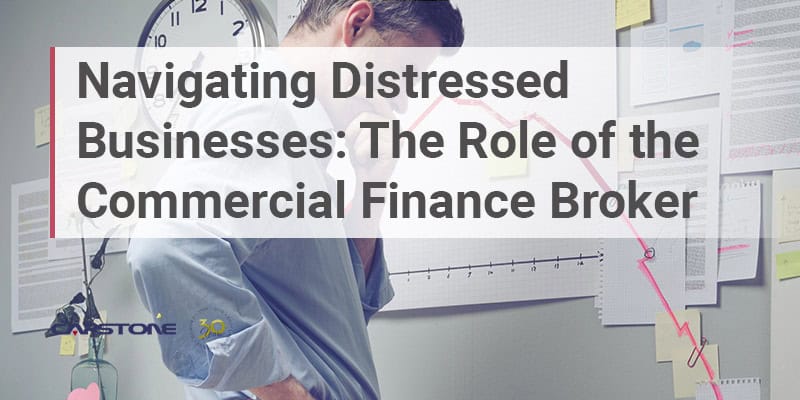Nearly every company will face financial challenges or periods of underperformance at some point in their existence. These challenges are a natural part of the business lifecycle and test the resilience and leadership of the organization. Depending upon the severity of the issues, a company may be labeled as a “distressed business,” which carries a connotation of complexity.
For commercial finance brokers looking to assist their distressed business clients, adopting a proactive approach can transform challenges into opportunities for profitability and growth. This strategy enables long-term stability and success for their clients in an ever-evolving economic landscape.
Recognizing the Warning Signs
Commercial finance brokers play a crucial role in identifying distressed businesses. While positioned at the frontline, their intimate knowledge of clients’ operations and financial needs allows them to spot red flags early on. When faced with a struggling business, these brokers should prioritize their clients’ needs.
A distressed business has financial and/ or operational problems, which, if not addressed promptly, can harm the organization. Some early warning signs of distress include:
- Sustained declining or negative cash flow
- Declining working capital
- Bank overdrafts
- Revolver drawdowns
- Violation of lending covenants
- Long cash conversion cycles
- Quality issues with services or products due to rushed work or poor materials
- Poor accounting systems and low financial reporting quality
Distressed businesses often need outside experts to help them identify the sources of their problems, and develop a turnaround plan to stabilize the situation and take the necessary steps to correct the problems.
How Does a Business Become Distressed?
A business can become distressed due to various factors, such as a recession, restrictive monetary policy, higher interest rates, public health emergencies, natural disasters, increased competition, poor financial management, outdated product lines, inflation, inability to pass cost increases on to customers, unprofitable projects, and changes in technology.
Ultimately, if there is a delay in taking action to resolve financial or operational problems caused by the above factors, a business can become distressed and may face a liquidity or insolvency crisis that jeopardizes its existence. This can include vendors cutting off credit, cash on delivery of product (COD), missed payrolls, taxes not being paid, missing 401K contributions, and working capital turning negative.
Time is of the Essence
Ideally, a business owner will recognize the early warning signs of their business being in distress and seek guidance from the financial professionals they have confidence in. Unfortunately, many business owners are often optimistic and believe they can work their way out of the financial issues by keeping their cash flow up and flowing even if the work is not profitable not realizing they are digging themselves into a deeper hole. Many times, experienced business owners don’t know when to act or where to turn for assistance.
Distressed businesses owners may underestimate how quickly things can spiral out of control. When vendors cut off credit and customers cancel orders, the repercussions reverberate throughout the industry fast. What may have begun as a minor issue with a vendor and a customer can escalate into an irreversible crisis. For the business owner, the stakes are high: they may face the daunting prospect of selling part or all of their business, filing for bankruptcy or even shutting down entirely.
The core objective is to stem financial losses and reverse declining cash flow quickly so that the owner can buy time to implement the turnaround plan.
Key Steps for Commercial Finance Brokers
There are several key steps that commercial finance brokers can consider to help steer the distressed business client back toward profitability and stability.
- Assess the Situation:
- Thoroughly assess the client’s financial situation. Understand the root causes of their financial distress, which may include cash flow issues, declining revenues, excessive debt, high inventory levels, slow paying customers, defaulted customers or operational inefficiencies.
- Identify critical areas that need immediate attention, such as liquidity, debt obligations, and operational challenges.
- Collaborate with the Experts:
- Engage with professionals who specialize in turnaround management and restructuring, such as business consultants, accountants, and legal advisors. These experts can provide valuable insights and guidance.
- Consider partnering with firms that offer restructuring and turnaround financing services.
- Develop a Turnaround Plan:
- Help the client and turnaround professionals create a comprehensive turnaround plan. The plan should address both short-term and long-term goals.
- Prioritize actions that will stabilize the business, improve cash flow, and enhance profitability.
- The business should consider restructuring debt, renegotiating contracts, and improving operations.
- Liquidity Management:
- Focus on helping the client improve liquidity. Review options such as asset-based lending and accounts receivable factoring to increase and accelerate cash flow.
- Invoice factoring unlocks and accelerates cash flow tied up in unpaid invoices. It is an excellent solution to provide immediate working capital.
- Work Closely with the Client:
- Maintain client commitment and communication. Work with the client’s management team and put the client first. This will ensure client satisfaction.
Commercial finance brokers can utilize their expertise to provide valuable advice and financing solutions to distressed businesses. They can explore and guide clients toward alternative funding programs to immediately unlock liquidity if traditional business funding is not feasible.
If necessary, these professionals can refer clients to other financial experts or institutions that offer suitable solutions. They can leverage strategic partnerships to extend capabilities and provide additional support.
Invoice Factoring for Effective Liquidity Management
When a business faces financial distress and operational disruptions, swift and decisive actions become crucial. Providing your clients with a clear roadmap and having an experienced team to assess root causes and implement immediate solutions is vital. Understanding the available services and knowing the right time to engage a turnaround professional can make all the difference.
Capstone can play a key part in a turnaround plan for distressed businesses. Our invoice factoring programs are an excellent liquidity management tool for distressed businesses. They help stabilize and accelerate cash flow, and unlock much-needed working capital tied up in customer invoices. This provides access to instant cash flow to pay off outstanding debts or lines of credit and provides much needed working capital.
Our invoice factoring programs are custom-tailored to fit the needs of your client and are faster, easier, and more flexible than business funding from other traditional lenders. Invoice factoring is a proven short-term (or long-term) turnaround management tool that has been employed in many successful turnaround plans. Working with an experienced factoring company, such as Capstone, will ensure optimal success and benefits of an invoice factoring program for your clients.
Let us work with you to find the best liquidity management strategy. Contact our skilled team of representatives today.




